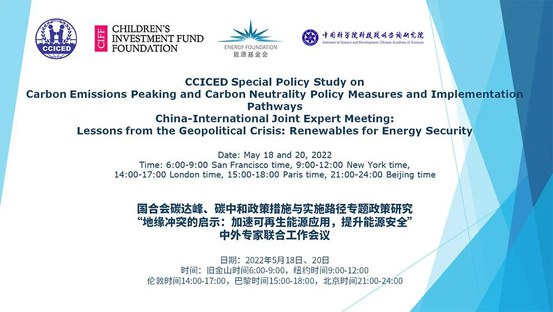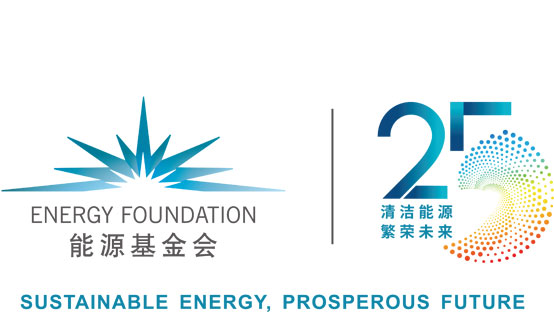Renewable Energy to Approach Nations Energy Independence and Security, to Accelerate Global Energy Transition and Cooperation
Nations should strive for energy independence, energy security and climate security by ramping up investments in renewable energy. When Minister Xie and special envoy, Secretary John Kerry signed the US-China Joint Statement, it showed that notwithstanding the friction in the overall relationship, particularly in the trade relationship, we can find a common ground in the clean energy. Although we are in a period, quite frankly, characterized more by competition than cooperation, we should leverage healthy competition in developing renewable technologies and expanding their practice. This is a chance to cultivate a race to the top to be energy independent and to put renewables at the heart of that transition.

Russia's invasion of Ukraine has shone a bright light on the fact that energy independence and energy security are core national security issues. An energy sector that is either heavily reliant on foreign supply or on a volatile global market is one that is dangerously exposed.
Countries across the globe have felt the pain of rising energy and food prices. Gasoline prices skyrocketed by almost $70cts/gallon in 2-week period following the invasion. The UK energy bills have risen by over 50%. This shock to the global economy is increasing prices in other areas across food and other goods. This vulnerability was present long before the invasion of Ukraine. For decades, nations have chosen to build economiesheavily dependent on fossil fuels, leaving them deeply vulnerable to market fluctuations. During periods of volatility, the knee-jerk responsehas been to double down, that that’s led to more fossil fuel production, more locking in of fossil fuel infrastructure, more vulnerability. Countries have kicked the can down the road and in doing so have left themselves unguardedand this has set the stage for today’s event. In 2021, 2/5 of the gas, 1/4 ofimported crude oil and 44% of imported coal that Europeans burn came from Russia. China surpasses the US on annual imports in 2017, and today is the world's largest importer of a crude oil and natural gas.
Oil and increasingly natural gas are global commodities with inelastic demand, which means policies to increase fuel production have limited ability to stabilize prices. That's why even though the US is producing their record highs of oil, prices continue to hover in the stratosphere.
The most vulnerable people in the world are most exposed. The people who ironically contributeleast to the problem face the greatest impact from the threat of climate change. In the US, we have seen progress to some extent, but we still await real action on the investments that are necessary to meet President Biden's goal of cutting US emissions 50% by 2030. In China, we see progress in the development of clean energy, but still the over reliance in this critical decade on coal and production of energy from fossil fuel remains.
Nations should strive for energy independence, energy security and climate security, specifically by ramping up investments in renewable energy. A clean energy economy is the only way to go against the volatility of global fossil fuel markets and stave off sky high prices, as well as the only way to avoid a climate disaster.
It seems that nations and governments are finally taking notice. The European Commission announced plans to make European energy demand independent from Russia fossil fuels well before 2030. Key to this plan is an acceleration in the roll out of renewables, as well as greater investments in energy efficiency and replacing gas in heating and power generation. Estimates have suggested that this plan can reduce EU demand for Russian gas by 2/3 by the end of this year alone. At the same time, the European Commission has also proposed to raise its renewable energy target from 40 to 45% by 2030 while increasing its solar energy capacity two-fold by 2028. Germany, in particular, has ushered in some of the most sweeping energy policy reforms in decades. It plans to triple its build out of renewables over the next decade and reach 100% in its power mixed by 2035, matching the US commitment.
President Biden signed vital investments in the passage of the $1.2 trillion, Infrastructure Investments and Jobs Act, the largest infrastructure bill in the history of the US. This bill included billions of dollars towards low carbon infrastructure in transportation, electricity, charging stations, upgrading power grids as well as new green pilot projects, particularly in green hydrogen. And the President is pushing to do more. Congress still can pass legislation that would invest $500 billion into the clean energy economy. That possibility rides on the vote of a single US senator, but some of us at least remain committed to trying to ensure that happens and remain hopeful that still is a possibility in the next several weeks or next couple months. China has also been making significant investments and renewable energy. It is also spent nearly $760 billion between 2010 and 2019 and billions more in clean energy technologies and renewable power generation both in China and abroad.
It's clear that China and the US share common ground in developing a world where renewable energy and innovation continues to play a larger and larger role. For both nations that presents an opportunity to increase energy security through the diversification of renewable energy supply chains, and the opportunity to boost domestic manufactured. We're in a period, quite frankly, characterized more by competition between the US and China and between the EU and China, rather than cooperation. The ability to cooperate globally in a multilateral forum is the dominant way by which we're operating but we’re in a period of serious competition. A bright spot in cooperation came in Glasgow when Minister Xie and special envoy, Secretary John Kerry signed the US-China Joint Statement, showing that notwithstanding the friction in the overall relationship, particularly in the trade relationship, we can find a common ground in the clean energy. We should leveragehealthy competition in developing these technologies and expanding their installation.
Healthy competition has been the impetus behind the recent passage of bills in the US, like the US Innovation and Competition Act, which can really leadto breakthroughs in low carbon technology, spur major investments in renewable energy and infrastructure, and particularly in building out the kind of manufacturing supply chains that are going to be necessary if the world is going to meet its clean energy goals.
If China and the US and the EU can set the tone and adopt a renewable centered approach to energy security, we can revolutionize the global energy landscape and create the momentum necessary to lift ambition on climate goals. The downstream effects on the global economy and on the development trajectory of lower income economies would be immense. We have an incredible opportunity to change the landscape of the global energy economy. This is a chance to cultivate a race to the top for nations to be energy independent and to put renewables at the heart of that transition. After decades of the international community doubling down on fossil fuels, I’m optimistic that the changes we're seeing nowsignal a turning of the tide.




